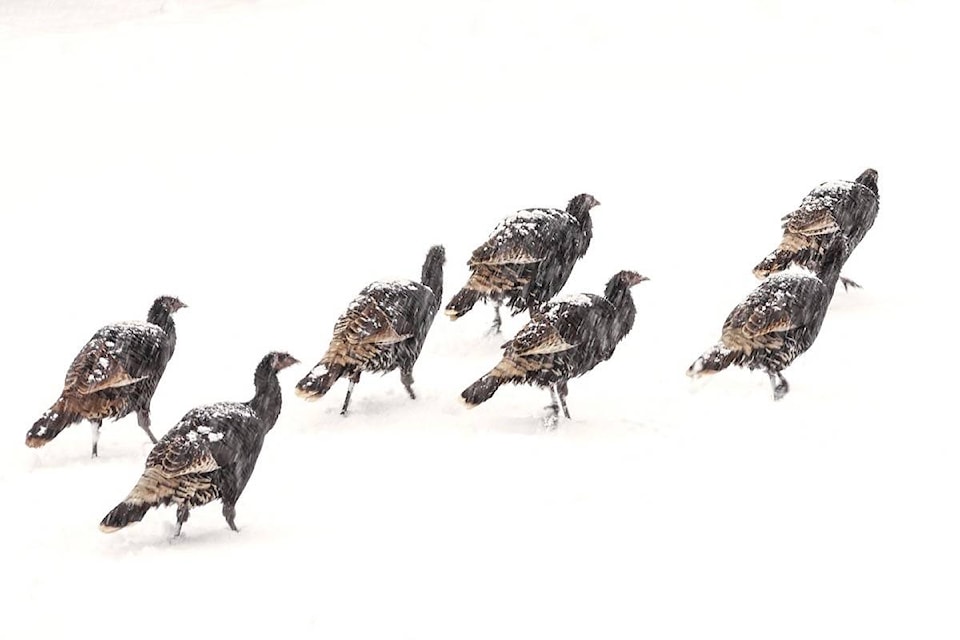There were no rare birds spotted during this year’s local Christmas Bird Count (CBC).
Most of the birds counted are in the region year round, said Rossland-Warfield compiler Linda Szymkowiak.
However, the one main thing missing, she pointed out, were totals from Trail and Beaver Valley.
“There wasn’t a count organized for Trail-Beaver Valley this year,” said Szymkowiak. “Hopefully it will occur next year.”
The people who usually spearhead the Trail-Beaver Valley count are finding it increasingly harder to get out and about in the winter to count birds and, unfortunately, few people have stepped up to fill the gap.
Nevertheless, the count did occur in the Rossland-Warfield area on Dec. 15 and the totals were just recently tabulated and released.
“There were no rare sightings in this year’s count,” said Szymkowiak told the Trail Times.
“By rare I mean birds that would be very unusual to be here or to be here now. All the birds listed are either birds who are here year round, like the woodpeckers and chickadees or those like the robins who are lingering longer due to a later starting winter and lots of winter fruits on trees such as mountain ash berries and crab apples.”
A total of 22 species were spotted and a combined total of 515 birds compiled. The area covered goes from Annable, through Warfield to the Rossland townsite and Happy Valley, from Highway 22 to Paterson and along the Centennial Trail and up to Blackjack.
Szymkowiak reported Dec. 15 was a sunny day with a light breeze and temperatures ranging from -5C to 2C.
The conditions were perfect and led to some surprises thanks to keen counters.
“Thanks to a newly arrived, keen-eyed birder with even keener hearing, the count includes a few birds that are a challenge to find,” added Szymkowiak.
“These include the three-toed woodpecker, red crossbills, Townsend’s solitaire and golden-crowned kinglets, birds that are found in the forest, not at feeders or in town.”
Those species were spotted along Rossland’s Centennial Trail.
The Rossland-Warfield totals showed an abundance of pine siskin (105), black-capped chickadees (77), American goldfinch (53), American robin (41) and wild turkeys (28).
Szymkowiak said no Bohemian waxwings, evening grosbeak, common redpoll or pine grosbeak, species that come here from further north, were spotted on counting day.
“Since the count we have seen increasing numbers of Bohemian waxwings arrive here. These species often arrive in large numbers so their absence this year resulted in less species and less total numbers of birds counted.”
She noted this 2018 CBC had the lowest number of species (22) and the lowest total number of birds (515) since 2004. The highest number of species was 36 in 2006 and in 2013. The highest number of birds counted were 1907 in 2011 and 1865 in 2004.
Last year, with the Trail-Beaver Valley count included, a total of 36 species and 1,302 birds were tallied.
“One other factor in the numbers of species and total number of birds is having enough field observers to cover all the areas,” explained Szymkowiak.
“We did not have coverage this year in Rivervale which may have resulted in the listing of a few waterfowl from the Columbia River such as Canada Geese and Mallard Ducks.”
Nevertheless, carrying on a tradition that entered its 119th year in North America can’t be accomplished without participants, she emphasized.
“I want to thank all of our bird count participants, those who watch their feeders for hours and those who head out to farmland or forest or riverbank no matter the weather to find the birds.
“Without their effort and commitment, we would not have a count. Without a count we lack data for researchers to compare and to get a perspective on the status of our wild birds.”
